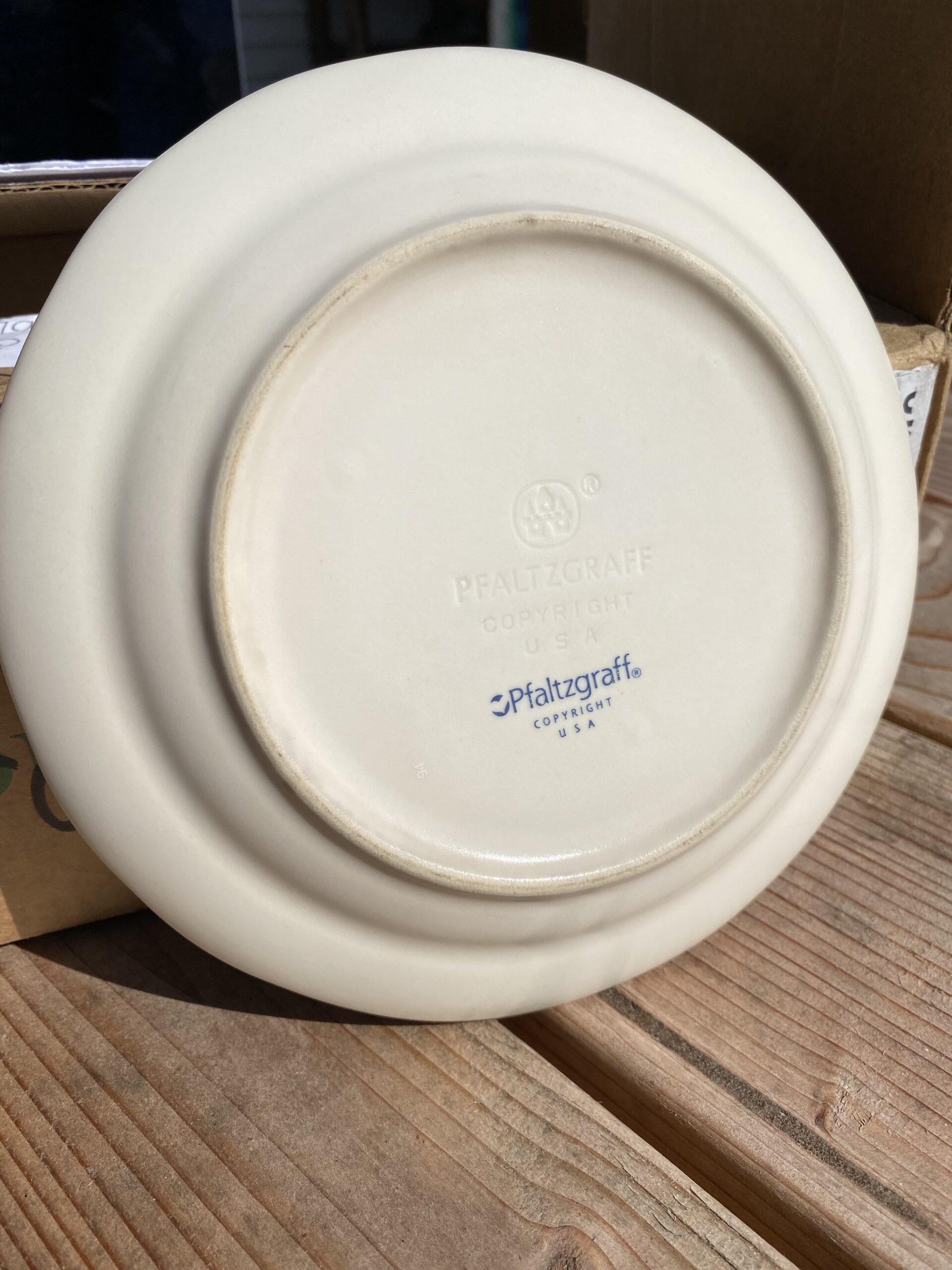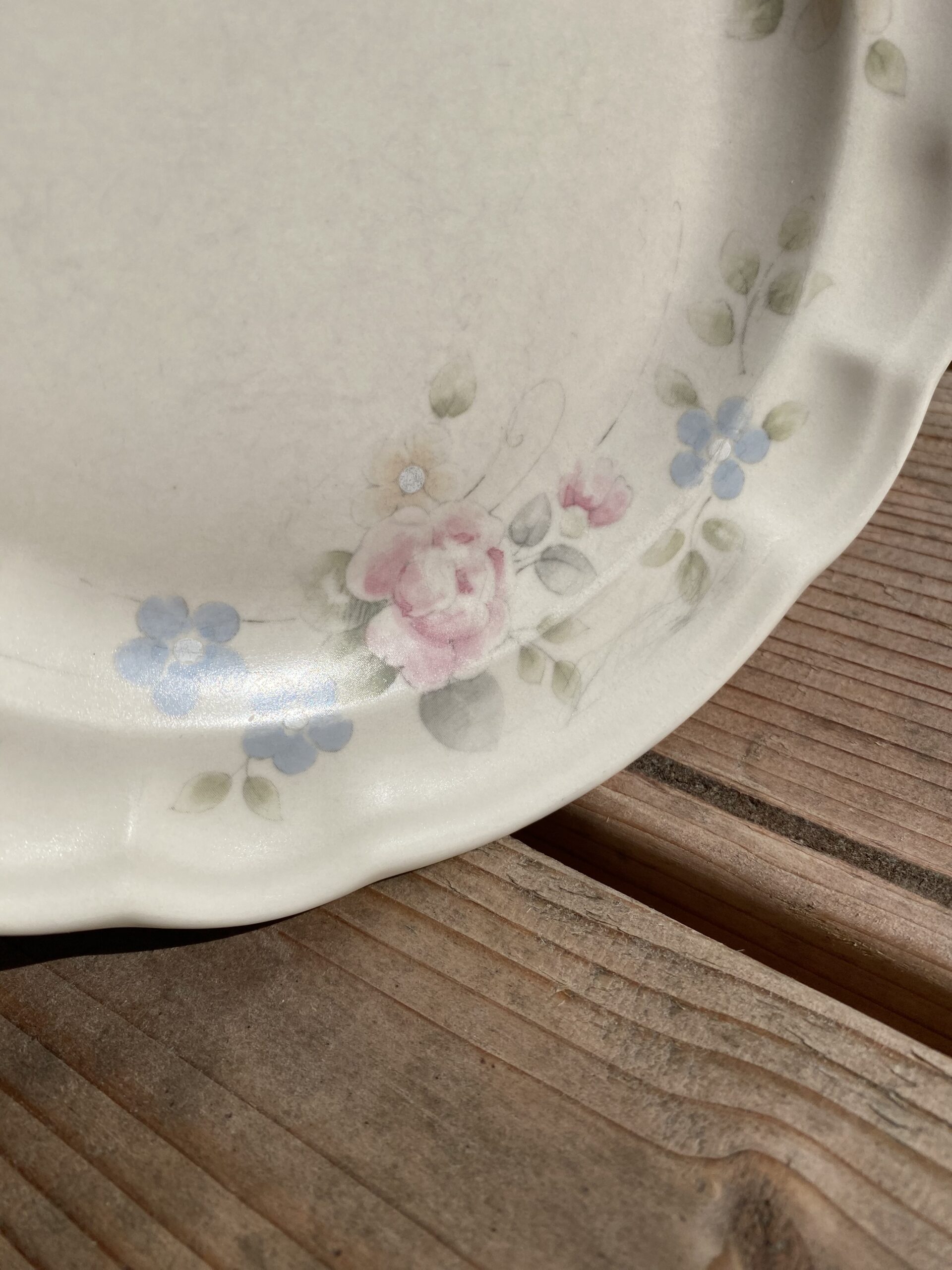Made in USA Pfaltzgraff floral print (vintage tea rose pattern) creme-glazed ceramic dish: As high as 3,711 ppm Lead on the food surface (90 ppm and up is unsafe for kids)
For those new to the Lead Safe Mama website:
Tamara Rubin is a multiple-federal-award-winning independent advocate for childhood Lead poisoning prevention and consumer goods safety, and a documentary filmmaker. She is also a mother of Lead-poisoned children (two of her four sons were acutely Lead-poisoned in 2005).
- Tamara owns and runs Lead Safe Mama, LLC — a unique community collaborative woman-owned small business for childhood Lead poisoning prevention and consumer goods safety.
- Since July 2022, the work of Lead Safe Mama, LLC has been responsible for six product recalls (FDA and CPSC).
- All test results reported on this website are science-based, accurate, and replicable.
- Please check out our press page to see some of the news coverage of our work, linked here.
March 18, 2023, Saturday
XRF Test Results for the Dish Pictured
Sent in by a Lead Safe Mama Reader (from Indiana) for Testing
Context: Total Lead-content (as detectable with an XRF instrument) in the paint, glaze, or coating of an item manufactured for use by adults is not regulated in any way. Dishes are considered “items intended for use by adults” (not items intended for use by kids, even though kids use dishes), unless they have been expressly manufactured and sold as children’s dishware (for example: Dishes sold as baby dishes by Bunnykins/Royal Doulton [link], Tiffany & Co [link] or Wedgwood/Beatrix Potter [link]). Modern children’s items (made today) are not legally allowed to have Lead levels above 90 ppm in the paint, glaze, or coating.
Most important consideration: Vintage dishware was often manufactured before modern leach-testing standards were in place (regardless of whether or not there were relevant total-content standards at the time of manufacture). Given it is rare for a set of dishes to be marked with the date of manufacture, users of these products often have no idea of the actual age, which could indicate whether or not they were leach tested at the time of manufacture). In addition to this concern, even if vintage dishes were manufactured after modern leach-testing standards were in place, those standards are only relevant at the time of manufacture (when the dishes were new). If a product is compliant with leach-testing regulatory limits at the time of manufacture yet still has high levels of Lead in the glaze, it may leach Lead at some point in the future (especially after years or even decades of daily use in a home). It is for this reason we recommend never using vintage dishware that tests positive for any amount of Lead (especially for levels of Lead at 90 ppm or higher) on the food-contact surface of the dish.
Some additional reading:
- To read more about the concern for Lead in pottery, click here.
- For the menu to our website (to look through different item categories), click here.
- To see XRF test results for more Pfaltzgraff pieces we have tested, click here.
- To learn more about sending in an item from your home for Lead Safe Mama, LLC to test, click here.
Color-code Key for XRF Readings Below:
Metals noted in RED are considered toxic heavy metals in most applications.
Metals noted in BLUE are not considered toxic in this application.
Metals noted in GRAY were not found to be present (with the low threshold of detection for the XRF instrument normally falling in the single or double digit ppm for most metals).
Reading #1) Creme-Colored Center of Food Surface on Dish
(60-second test repeated multiple times to confirm results):
- Lead (Pb): 70 +/- 11 ppm
- Cadmium (Cd): non-detect
- Tin (Sn): non-detect
- Mercury (Hg): non-detect
- Selenium (Se): non-detect
- Barium (Ba): 44 +/- 29 ppm
- Chromium (Cr): non-detect
- Antimony (Sb): non-detect
- Copper (Cu): 144 +/- 28 ppm
- Zinc (Zn): 36 +/- 13 ppm
- Zirconium (Zr): 3,829 +/- 82 ppm
- Iron (Fe): 1,033 +/- 128 ppm
- Vanadium (V): non-detect
- Platinum (Pt): 64 +/- 29 ppm
- Cobalt (Co): non-detect
- Bismuth (Bi): 36 +/- 9 ppm
- No other metals were detected in consumer goods mode.
Reading #2) Pink Floral Design on Food Surface of Dish
(60-second test repeated multiple times to confirm results):
- Lead (Pb): 1,528 +/- 54 ppm
- Cadmium (Cd): 15 +/- 4 ppm
- Tin (Sn): non-detect
- Mercury (Hg): 35 +/- 17 ppm
- Selenium (Se): non-detect
- Barium (Ba): non-detect
- Chromium (Cr): non-detect
- Antimony (Sb): non-detect
- Copper (Cu): 97 +/- 29 ppm
- Zinc (Zn): 75 +/- 17 ppm
- Zirconium (Zr): 2,964 +/- 70 ppm
- Iron (Fe): 946 +/- 136 ppm
- Vanadium (V): non-detect
- Platinum (Pt): 110 +/- 40 ppm
- Cobalt (Co): non-detect
- Bismuth (Bi): 24 +/- 13 ppm
- No other metals were detected in consumer goods mode.
Reading #3) Blue Floral Design on Food Surface of Dish
(60-second test repeated multiple times to confirm results):
- Lead (Pb): 3,711 +/- 93 ppm
- Cadmium (Cd): 79 +/- 7 ppm
- Tin (Sn): 50 +/- 9 ppm
- Mercury (Hg): non-detect
- Selenium (Se): non-detect
- Barium (Ba): non-detect
- Chromium (Cr): 1,221 +/- 327 ppm
- Antimony (Sb): non-detect
- Copper (Cu): 131 +/- 29 ppm
- Zinc (Zn): 349 +/- 30 ppm
- Zirconium (Zr): 3,415 +/- 78 ppm
- Iron (Fe): 1,040 +/- 132 ppm
- Vanadium (V): 3,354 +/- 664 ppm
- Platinum (Pt): 1467 +/- 44 ppm
- Cobalt (Co): 427 +/- 72 ppm
- No other metals were detected in consumer goods mode.
Reading #4) Logo Area on Back of Dish
(60-second test repeated multiple times to confirm results):
- Lead (Pb): 45 +/- 12 ppm
- Cadmium (Cd): non-detect
- Tin (Sn): non-detect
- Mercury (Hg): non-detect
- Selenium (Se): non-detect
- Barium (Ba): non-detect
- Chromium (Cr): non-detect
- Antimony (Sb): non-detect
- Copper (Cu): 165 +/- 30 ppm
- Zinc (Zn): 789 +/- 43 ppm
- Zirconium (Zr): 3,865 +/- 83 ppm
- Iron (Fe): 1,170 +/- 132 ppm
- Vanadium (V): non-detect
- Platinum (Pt): 98 +/- 34 ppm
- Cobalt (Co): 2,338 +/- 132 ppm
- Bismuth (Bi): 270 +/- 18 ppm
- No other metals were detected in consumer goods mode.
In Conclusion:
If you have these dishes and have been using them as your everyday china, you may want to consider asking your doctor about getting a Blood Lead Level (BLL) test to rule out any potential exposure. Here’s a link with more information about BLL testing. Given BLL testing tends to show immediate recent exposure (there is a 30 to 45 day half-life of Lead in the blood), if you are concerned more about long-term exposure you can ask your doctor about the possibility of getting a hair or a urine test. Here’s a link with more information about those types of testing. If you are looking for examples of Lead-free dishes to use as alternatives, please check out this link.
Never Miss an Important Article Again!
Join our Email List













When your post popped into my email I immediately went to your website to read more. I have a large set of Tea Rose, some probably dating back to 1990 and a few recently purchased a few years ago. I’ve bought serving pieces from garage sales, received them as Christmas gifts over the years, and some plates from Goodwill. Where do I start? I tried to research the markings but the only ones I feel that I might be able to trust are if it says, ‘microwave and dishwasher safe’ as I have at least 4 different markings. One made in Mexico, some that might be truly vintage as it has the long castle. I’ve always washed dishes by hand but have numerous ones with chips or lines. My first thought is to pitch it all and buy Corelle. We have a young grandson who is ADHD and I try to be careful about food additives etc., now it’s my dishes I’m concerned about. I also feel that I shouldn’t pass these on to anyone else, not Goodwill, not leaving it for someday to be in my estate (lol what little I have). I don’t think testing them all is affordable, it would probably cost less to buy a simple set of 4 from Corelle and add little by little. For now, I’m going thru everything and pitching anything that is cracked, chipped or has lines in it.
Was reading this while eating on one lol needless to say it’s in the garbage now smh